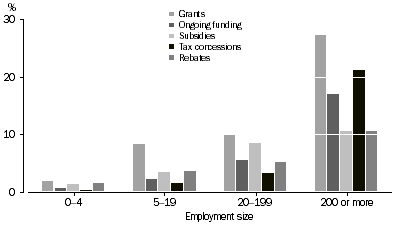BUSINESS FINANCE
Business finance sought
All businesses were asked to indicate if debt or equity finance had been sought during the year ended 30 June 2006. If finance had been sought, the business was asked to identify the type of finance; status of finance sought (i.e. whether it had been obtained, not obtained or still in progress); and the reasons for seeking finance. Debt finance includes any finance the business must repay while equity finance includes finance provided for a share in the ownership of the business. Businesses could report more than one type of finance sought, more than one status and multiple reasons for seeking finance.
A total of 18% of businesses sought debt or equity finance, with businesses that employed 20-199 persons having the highest proportion at 32%. Of businesses that sought finance, 91% sought debt finance and 24% sought equity finance. Of businesses that sought finance, 90% obtained it, 13% reported that finance was not obtained and 5% reported that finance sought was still in progress.
Overall, the most commonly cited reason for seeking finance was to maintain short-term cash flow or liquidity (40% of businesses that sought finance), then to ensure the survival of the business (29%) and replacement of other equipment or machinery (27%). To maintain short-term cash flow or liquidity was the most frequently reported reason across the three smallest employment size ranges, whereas for businesses that employed 200 or more persons, to expand the business was the most prevalent reason for seeking finance.
Government financial assistance
All businesses were asked whether any types of government financial assistance (excluding tax deductions for normal business expenses) had been received during the year ended 30 June 2006.
When interpreting proportions presented, the number of businesses in each employment size category varies significantly. Readers should be mindful that when comparing data across employment size categories, a higher percentage value does not necessarily equate to a larger number of businesses. For example, in the table below, 48% of businesses that employed 200 or more persons, representing approximately 2,000 businesses, received at least one type of government financial assistance. This compares to 7% of businesses that employed 0-4 persons, which represents approximately 31,000 businesses.
Government financial assistance, 2005-06(a)(b), by type, by employment size |
|  |
 |  |  | Employment size |  |
 |  |  | 0-4 persons | 5-19 persons | 20-199 persons | 200 or more persons | Total |  |
|  |
| Number of businesses(c) | '000 | 466 | 195 | 52 | ^4 | 716 |  |
| Type of financial assistance(d) |  |  |  |  |  |  |  |
 | Grants | % | 1.9 | 8.3 | 9.9 | ^27.3 | 4.3 |  |
 | Ongoing funding | % | 0.7 | 2.4 | 5.5 | ^17.1 | 1.6 |  |
 | Subsidies | % | 1.4 | 3.5 | 8.5 | 10.7 | 2.5 |  |
 | Tax concessions | % | 0.4 | 1.6 | 3.4 | ^21.3 | 1.0 |  |
 | Rebates | % | 1.5 | 3.6 | 5.3 | 10.6 | 2.4 |  |
 | Other government financial assistance | % | 1.4 | 3.2 | 3.1 | 3.6 | 2.1 |  |
 | Any government financial assistance | % | 6.7 | 18.6 | 27.9 | ^47.5 | 11.6 |  |
| No government financial assistance | % | 93.3 | 81.4 | 72.1 | ^52.5 | 88.4 |  |
|  |
| ^ estimate has a relative standard error of 10% to less than 25% and should be used with caution |
| (a) Proportions are of all businesses in each employment size category. |
| (b) Government includes federal, state, territory and local government. |
| (c) See Explanatory Notes 28 and 29. |
| (d) Businesses could identify more than one type of financial assistance. |
Grants were the most commonly reported type of government financial assistance, with 4% of all businesses having received grants. The proportion of businesses that received each type of government financial assistance increased across each successive employment size range in almost all instances. The proportion of businesses that reported no financial assistance from government during the year ended 30 June 2006 is 88%.
Type of government financial assistance, 2005-06

 Print Page
Print Page
 Print All
Print All